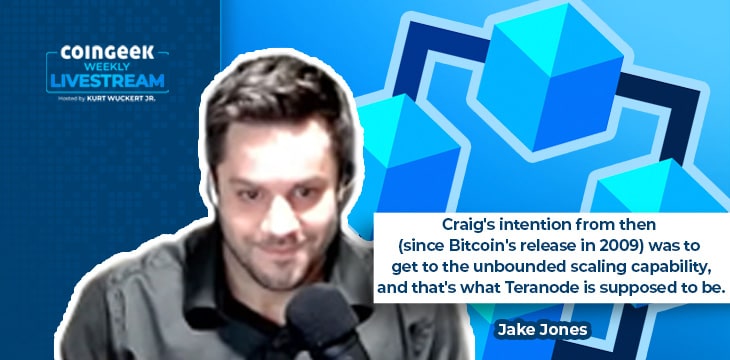|
Getting your Trinity Audio player ready...
|
This week on the CoinGeek Weekly Livestream, Kurt Wuckert Jr. was joined by Bitcoin Association’s Jake Jones to talk about the plan to take Bitcoin to unbounded scaling, what’s happening in the BSV ecosystem, and more.
A note about ‘proof of reserves’
Wuckert begins by mentioning the proof-of-reserves meme doing the rounds as exchanges and lending programs try to prove they are liquid.
He finds it curious that they are claiming they can’t prove their reserves on-chain for security issues while they never accepted the same reasoning from Dr. Craig Wright to prove his Satoshi coin stash.
It’s yet more evidence of the hypocrisy at the heart of the industry. While they have slandered and attacked Dr. Wright for taking his own security seriously, they are now playing the same card when it comes time to prove they are solvent.
Introducing Jake Jones
Jones is not a widely known figure in the BSV ecosystem, but he’s doing some important work behind the scenes. He tells the audience he followed the BCH/BSV saga and started with the Bitcoin Association two years ago. He wrote the hash functions course and eventually moved into engineering more recently.
Jones’s background is in computer science. He was introduced to Bitcoin in his early twenties and started mining with his friends with GPUs. It was short-lived, but it sparked his interest in Bitcoin. After working as a software engineer for many years, he found a video of Dr. Wright and was convinced he was legitimate.
What is Teranode?
Jones explains that Teranode is the successor to SV Node. It’s an iteration in the quest to get to unbound scaling. In order to get to unbounded scaling, horizontal scaling and microservices are required, and Teranode is part of that equation.
Where are we now? An alpha test has been done, and the team is attempting to show it can handle unlimited scaling. The hope is that this time next year, they’ll have something viable and ready to handle massive scaling. The whole idea is to make SV Node more powerful.
Jones then gives an in-depth technical explanation of what’s going on under the hood, including how they ensure everything is working properly and how they can implement microservices in a measured way.
Teranode—Some technical information
Wuckert asks Jones what he’d do differently if he were in the room with Satoshi in 2007, and he replies that he’d implement a mechanism for returning Merkle paths (some sort of a UTXO lookup).
What IDE are they using to work on Teranode? Jones says this is up to the developers, but most are using IntelliJ. Will people have the chance to build a Teranode client in Go or Rust? Jones says one of the advantages of a microservices architecture is the ability to take those elements out and build them however you want. The idea of building clients in different languages has been discussed.
How many TPS have they hit? We have already seen a live demo showing 50,000 and they’re trying for 100,000, and then they’ll go from there. Will Teanode signal the end for home miners? Wuckert would say it’s almost impossible already, and Jones concurs.
IPv6 and Bitcoin SV
Wuckert mentions that Bitcoin was IPv6 compatible years ago, and he wants to know what’s going on. He asks for a high-level overview of the situation.
Jones explains that there are a lot of advantages to using IPv6, including multicast and unicast. He says that Bitcoin micropayments require IPv6 to scale properly. There’s a nice symbiosis between the two, something which both Latif Ladid and Dr. Wright recognize. Professor Ladid realizes what Bitcoin can do for the internet, and both men are committed to building for the multi-decade term.
What are multicast and unicast? Jones explains that there are three types of addresses in IPv6; unicast, which is a one-to-one connection; anycast, in which a set of receivers have the same IP address; and multicast, which replaces broadcast from IPv4, allowing you to create groups that receivers subscribe to get packets of data.
Wuckert mentions Dr. Wright’s scaling ambitions for billions of transactions per second and asks what Bitcoin might look like ten years from now.
“I don’t think anybody knows that except Craig,” Jones replies. Even governments and corporations could run their own nodes on BSV.
What about mApi? It was developed at a time when it was needed, but what’s really needed now and going forward is a UTXO lookup, Jones says. These things are being worked on now.
What could be done with IPv6? Jones says one of the biggest ones is moving away from the advertising model to direct payments.
Closing comments
Wuckert asks Jones if there’s anything he wants people to understand about Bitcoin.
He replies that micropayments can truly change the world in many ways, and he encourages others to think of how they might change things. Microentrepreneurship, sending tiny payments, empowering the poorest people in the world, and other revolutionary things could be unlocked by micropayments.
Watch: CoinGeek New York conference, Teranode Live Demo showing 50k TPS on BSV Blockchain

 12-14-2025
12-14-2025 





